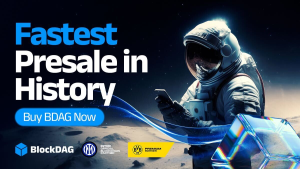- Chainlink is advancing, but top developers hint at ways it can improve.
- For Chainlink to transition into a full protocol, it needs self-service and staking to conform to existing rules.
Leading decentralized Oracle platform Chainlink (LINK) is constantly undergoing ecosystem development to revolutionize the network. A crypto community member with the username @ari_kiry on X has highlighted self-service and staking as key drivers to Chainlink’s evolution.
Chainlink’s Transition Journey Into A Protocol
@ari_kiry spotlighted a video presentation from Stakedotlink Founder Jonny Huxtable, in which he discussed the possibilities of using self-service to drive evolution in Chainlink. This function highlights how Web3 developers deploy smart contracts in EVM and non-EVM-based chains.
Self-service is the game changer that will evolve #Chainlink from being just a suite of products into a fully-fledged protocol. As @HuxtableJonny explains, staking is the key to making this shift possible
This topic has been heavily discussed recently, so here’s a breakdown pic.twitter.com/9WSubuLigf
— Ari DTCCIPed (@ari_kiry) October 16, 2024
In the presentation, Huxtable claims self-service is the key to transforming Chainlink from a suite of products into a complete protocol. The innovator also added that staking is essential to enabling this change. Web3 developers can easily deploy smart contracts on any chain with self-service. However, users still encounter barriers when creating Chainlink Decentralized Oracle Networks (DONs) and data feeds.
@ari_kiry envisions staking v1 as the catalyst for lowering that barrier. According to the presentation, staking will allow developers, protocols, and users to easily self-serve by creating their DONs. It will also assist them in launching new data feeds and building apps on top of Chainlink’s core services like CCIP, VRF, and others.
The developer emphasized that users will start seeing real change in transparency and incentives once staking goes live. In particular, they can see on-chain how much LINK is being paid by protocols for using Chainlink data. This makes it easier for rewards to rise over time as adoption grows.
As the Chainlink ecosystem grows, more node operators can participate and get rewarded, further highlighting increased transparency. @ari_kiry believes staking and self-service are essential to aligning data providers, node operators, and data consumers to benefit everyone.
The developer also painted a scenario in which anyone can set up their own Chainlink node, earn their reputation on-chain, and participate in various DONs. It was also acknowledged that this vision has yet to materialize but believes self-service will make it a reality.
Furthermore, staking allows users to contribute, build, and be compensated for supplying key infrastructures that make decentralized data feeds function. This transforms Chainlink from a suite of products to a protocol.
The goal is for Chainlink to transition into a fully decentralized ecosystem where anyone can participate and contribute to the data economy. In return, they receive real financial incentives.
LINK’s Current Price Movement
LINK, Chainlink’s native token, continues to see a downtrend in price. As of this writing, LINK was trading at $11.02, down by 1.5% in the past 24 hours. The trading volume decreased by 28% to $189.6 million within the same timeframe.
Despite this decline, technical analysis shows LINK is on track to experience a breakout soon.
As CNF mentioned in a recent report, LINK’s Bollinger Bands tightened, signaling a possible breakout above the $13 level. The Moving Average Convergence/Divergence (MACD) indicator further confirms this bullish outlook as it approaches the positive cross-over zone.















